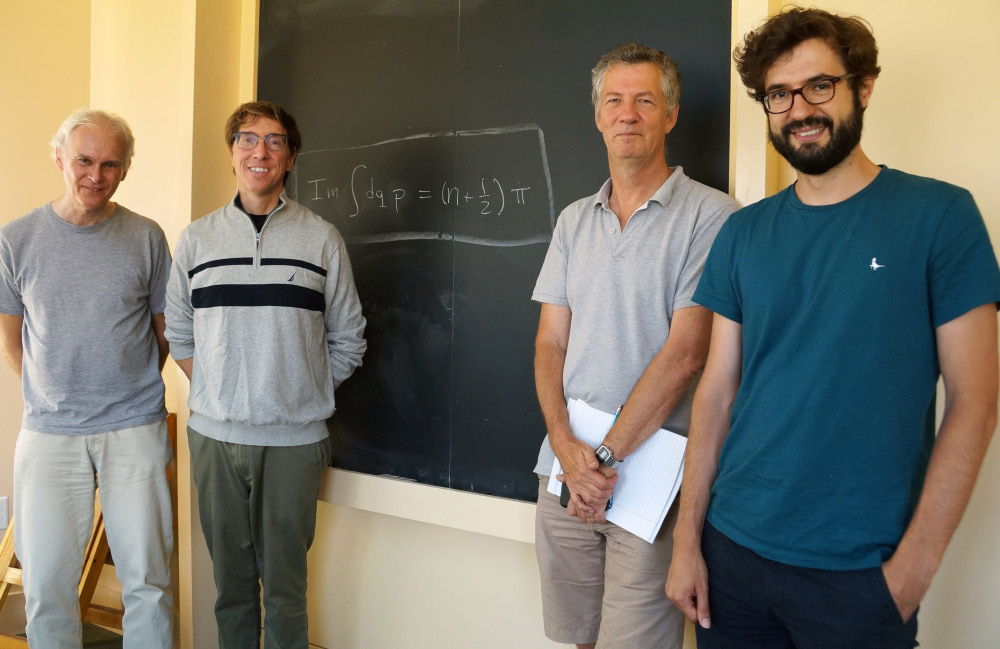 Left to right: Michael Wilkinson from Open University in the UK, KITP Deputy Director Greg Huber, Alain Pumir from Laboratoire de Physique in Lyon, France, and Marc Pradas from Open University.
Left to right: Michael Wilkinson from Open University in the UK, KITP Deputy Director Greg Huber, Alain Pumir from Laboratoire de Physique in Lyon, France, and Marc Pradas from Open University.
Photo by Sonia Fernandez.
Can the flapping of a butterfly’s wing over the Amazon really set off a hurricane in, say, Houston? The idea that small causes can have large effects would suggest it is a distinct possibility.
In chaos theory, however, the so-called Butterfly Effect — the sensitive dependence on initial conditions in which a small change in one state of a deterministic nonlinear system can result in large differences in a later state — may not apply. At least that’s the hypothesis of a group of theoretical physicists who met last month at KITP.
As participants in the institute’s Follow-on Program, they returned to the KITP for a week or two to work in small groups on projects initiated there earlier this year. Through the Follow-on Program, the physicists had the opportunity to finish works in progress or write papers together.
“The idea is to allow people to continue collaborations in one physical location,” said Deputy Director John Berlinsky. “The program gives us the opportunity to see long-term outcomes we wouldn’t normally be able to discern.”
Among this year’s participants were three returning visitors who worked with the Deputy Director Greg Huber on an outgrowth of “New approaches to non-equilibrium and random systems: KPZ integrability, universality, applications and experiments,” a previous two-month program devoted to the Kardar-Parisi-Zhang (KPZ) equation, a mathematical description of the temporal change of an interface at a particular place and time. That session explored recent progress on the KPZ equation from both a mathematics and a physics perspective.
“Our motivations come from quite a different angle than that program,” Huber explained. “The original program exposed connections between all kinds of problems that on the surface seem very different. Some of those problems had to do trajectories of particles and others with the interfaces between two states of a material or two phases of matter. We focused on trajectories but with a connection to turbulence and chaos.”
The theorists examined simplified chaotic systems — models for the turbulent kicks experienced in fluid flows — and found some surprising properties. Typically in such systems, trajectories separate at exponentially increasing rates. However, the researchers found that certain trajectories showed a tendency to cluster together.
“We’ve been trying to understand what lies behind this and also to think about its implications,” said Michael Wilkinson, a theoretical physicist at The Open University in the United Kingdom. “We’re pretty close to getting a good understanding of it. There are one or two hard mathematical results that we have yet to show conclusively but for which we are getting strong evidence.”
It seems that in chaotic systems while almost everything separates exponentially, there is at least one trajectory that is forever contracting. The Follow-on group is developing quantitative measures of the structure of these patterns, which have the property of being a fractal or self-similar — looking the same when viewed up close or from farther away.
The first Follow-on participants returned to KITP in 2015. One particularly enthusiastic gathering studied the deformation properties of two types of solid materials, including bulk metallic glasses, which may one day be used for cellphone casings. During their two-week stay, the team of five submitted six manuscripts to peer-reviewed journals and two papers to arXiv, a preprint library that posts thousands of physics, mathematics and computer science articles. The group also started a ninth paper and now, more than a year later, is preparing a tenth, with more forthcoming.
“Those extra two weeks at the KITP significantly strengthened our collaborations and gave us the time and space to initiate new synergistic group efforts,” said Karin Dahmen, a professor of condensed-matter physics at the University of Illinois at Urbana-Champaign. “Not only did the program provide a unique opportunity to finish discussions and joint work that we had started at the KITP, it also helped us think up new ideas and design new projects that could lead to groundbreaking larger research projects for the next decade or longer.”
The Follow-on Program, thanks to funding from the Kavli Foundation, allows theorists to delve more deeply into topics that interest them, while at the same time bolstering the KITP mission: to foster discovery and collaboration.
“The program is a nice tool that we can use to identify work that had some impetus here and then shepherd it toward completion,” said Huber. “And that fits into the goal of our institute as a whole.”
- Julie Cohen, UCSB Public Affairs & Communication
KITP Newsletter, Fall 2016
